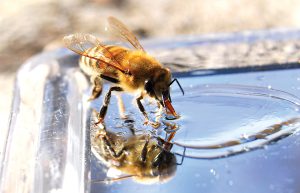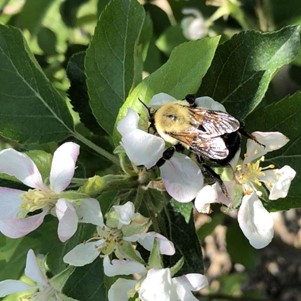By: Frank Linton

Photo by Fred Gimeno
In Winter, bees generate warmth by ‘burning’ the honey they have stored, i.e., by digesting it and using the resulting energy to flex their flight muscles, which give off heat. Also, they form a tight cluster to keep the heat within; they do not heat the hive, only their cluster.
For many beekeepers it is standard practice to put a thick layer of something atop the hive, on the inside, to ‘absorb the moisture’ that is produced by the bees’ respiration during the winter. The purpose of this absorbent layer is to prevent water condensing on the ceiling of the hive, dripping down and wetting the bees, cooling them, and destroying the colony by freezing it.
The water comes from the ‘combustion’ of the honey; the products of combustion being carbon dioxide (CO2) and water (H2O). The water is exhaled as vapor and condenses on the cold walls and ceiling of the hive.
It is my contention that so much water is produced by the bees’ digestive process over the winter that no reasonable amount of absorbent material could contain it. Instead, what is happening, I contend, is that the thick layer of ‘something’ acts as insulation, preventing condensation on the top of the hive, so that condensate forms only on the walls of the hive, where it either freezes or runs down the walls, harmlessly, in either case.
OK, so how much water is produced when a super of honey is digested?
We can compute the answer: Let us assume there is 40 lb. of honey in the hive for the colony to consume.
40 lb. x 18% is 7.2 lb. of water; nearly a gallon (8.3 lb.)
Of course, the hive has some ventilation during the Winter, which provides the bees with oxygen and carries off excess CO2, for example, and it is reasonable to assume that some of the exhaled water vapor will leave the hive by way of this ventilation. But let us focus here on the quantity of water produced.
So our question is, for each pound of honey consumed by the bees, how many pounds of water are produced?
The formula for both fructose and glucose is C6H12O6. Digesting (burning) the honey requires additional oxygen; six O2 molecules, to balance the chemical equation:
C6H12O6+6O2 = 6CO2 + H2O
To put this into plain English, one molecule of sugar (C6H12O6) and six molecules of oxygen (O2) yield six molecules of carbon dioxide (CO2) and six molecules of water (H2O). After removing the water, the 40 lb. of honey is 32.8 lb. of sugars.
To compute the amount of water produced we first have to convert the molecules of sugars to moles. Do you remember your high school chemistry? I did not. I had to look this up. I also had a chemist check my work.
First, you look up the atomic masses of the atoms involved:
- Atomic mass of carbon is 12
- Atomic mass of hydrogen is 1
- Atomic mass of oxygen is 16
Then you can compute the molecular mass of the sugar:
- 6 carbons x 12: 72
- 12 hydrogens x 1: 12
- 6 oxygens x 16: 96
The sum of these is the molecular mass of the sugars: 180.
That is, one mole of the sugars is 180 grams.
We see from the chemical equation above that each molecule of sugar produces 6 molecules of water. Computing the molecular mass of water:
- 2 hydrogens x 1: 2
- 1 oxygen x 16: 16
The molecular mass of water is 18, but recall that six water molecules are produced for each molecule of sugar. Multiplying:
- 6 molecules of water with molecular weights of 18 each, total: 108
That is, one mole of the water is 18 grams, and the six moles of water that form from one mole of sugars is 108 grams.
Now we can find the weight of the water produced by digesting honey by using proportions:
The proportion is:
Molecular weight of the water / Molecular eight of the sugars = pounds of water / pounds of sugars
Putting in the numbers from above
108 / 180 = ‘?’ / 32.8
Solving for the ‘?’ yields: 19.7 pounds of water – from ‘burning’ the sugars.
Adding the 18% water to this:
7.2 + 19.7 = 26.9 pounds of water
That is, 26.9 pounds of water are generated from our 40 pounds of honey (and the added oxygen from the air).
Given that a gallon of water weighs 8.3 pounds, our colony will produce over three gallons of water as it consumes its winter stores. A big sponge would be required to absorb this much water.
Keep in mind that this water is produced as vapor, over several winter months. Presumably, much of it is removed from the hive on departing air as it is replaced by fresh. However, if the water vapor should contact a cool inner surface before it exits the hive, it will condense, liquefy, and perhaps freeze.
The inner surface of the hive is cold in winter; there is no preventing it, and water vapor will condense on cold surfaces. If that cold condensate drips down onto the winter cluster it will be their end. You can prevent this by providing a small vent hole near the top of the hive to let moisture-laden air escape, and by heavily insulating the top of the hive so that moisture condenses on the hive walls, not at its top.
Frank Linton is an EAS-certified master beekeeper residing in Virginia.
http://colonymonitoring.com
http://thebeepeeker.com






